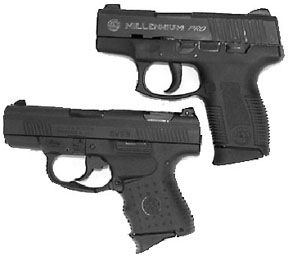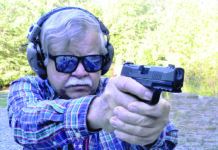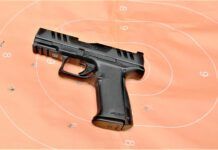
In this test we had a chance to shoot two 9mm pistols that take aim at Glock’s throne as the most popular polymer pistol. They are the Taurus PT 111 Millennium Pro and the Smith & Wesson SW99 Compact. Actually, we would classify both of these pistols as subcompact due to their overall dimensions, despite the suffix that follows the SW99’s name. However, both of these pistols do offer 10+1 capacity and, like the Glock, striker-fired operation. The Millennium Pro is made in Brazil and imported by Taurus. The SW99 is a design that was developed by Walther of Germany and is now a product of a joint operation with Smith & Wesson.
Each pistol tries to one-up the Glock design, and each other, by offering additional safety systems unique to the current slate of available polymer handguns. It didn’t take long to find out if either Taurus or Smith & Wesson had come up with a better mousetrap.
[PDFCAP(1)]Our first impression of the SW99 Compact is that a lot of attention must have been paid to making this gun fit the human hand. Most small guns suffer from poor ergonomics, but evidently Smith & Wesson wanted to make sure there was room for all four fingers on the grip. The base pad of the 10-round magazine adds a finger groove that helps the SW99 accommodate all but the largest of hands. A second magazine is supplied, but for some reason, possibly to give the option of a lower profile, the extra finger groove is not attached. An alternate partition that offers a different degree of palm swell is supplied to make the grip more versatile. This part slips into place and is held by a roll pin with only a hint of a seam. A simple tool is supplied for working the roll pin plus a wrench that makes changing the front sight an easy chore as well. Three extra front sights were supplied, each offering a different elevation point of impact. However, we found no need to change the grip or the front sight. The SW99 shot to point of aim and the grip was comfortable for everyone on our staff with the larger palm swell in place.
Had we wanted to move our point of impact left or right, the rear sight was click adjustable for windage. Adjustable sights are unusual in a small pistol, but the special features of this pistol do not end there. The slide offers cocking serrations fore and aft of the ejection port and an external extractor that is styled smoothly into the sleek lines of this pistol. Rather than clutter the profile with a decocking lever, an area of the slide within reach of the left hand thumb sits flush atop the slide. Press it and you go from single to double action. A cocking indicator protrudes from the rear of the slide but disappears when the decocking button is pushed. The grip frame is relieved in line with the trigger, making it easy to locate the trigger or rest the strong hand thumb. The trigger guard is generous in size and is contoured to guide the finger to the trigger. Keeping the gun slender and smooth was obviously of key concern. The slide release is tucked in close, and the magazine release is integrated with the rear of the trigger guard.
Field stripping the SW99 starts much the same way as the Glock, with two release levers found on each side of the frame. Actually the twin levers are serrated panels that are seated flush. We found them simple to operate. But we think some of these features were unnecessary or a liability in some cases. In our opinion, forward cocking serrations on a short-barreled gun can be dangerous. In this case there was less than 1.5 inches of slide forward of the trigger guard. A full size 1911, for example, has almost 4 inches of slide to grasp. The danger on the SW99 is placing a finger in front of the muzzle while working the slide from the forward serrations.
The decocker works well, but to return to single action you must either fire a shot double action or move the slide carefully rearward a short distance. Move the slide too far and you have ejected a live round. In terms of avoiding an accidental discharge, the trigger pull, even when the gun has been cocked, would require the type of definitive action that the double-action pull is supposed to represent. This is because merely cocking the gun does not reset the trigger to the rear of the trigger guard, such as found in other pistols operating with a traditional double-action design. The gun must actually have been fired for the trigger to stay back inside the trigger guard. This presents another possible liability. In operating the magazine release, it might be possible to also press the trigger. Since we found it difficult to depress the magazine release with our strong-hand thumb, some shooters tend to use their trigger or middle finger. Either way, we theorize that it is conceivable that in an attempt to release the magazine, contact with the trigger could be made.
[PDFCAP(2)]As we see it, the SW99 has a number of features that one can either love or not like at all. We did like the way it shot our selection of hollowpoint ammunition. Testing at 15 yards off a sandbag rest we found that printing groups of 2 inches or less was easy despite the fact that initial shots required a long manual take-up. The Speer 147-grain Gold Dot Hollow Point (GDHP) ammunition was our favorite. In terms of power, lighter and faster bullets generally score higher in terms of muzzle energy. But the difference in velocity between the 147- and 124-grain GDHP rounds was less than 110 fps on average. Muzzle energy was nearly identical for these two rounds, over 300 foot-pounds on average. But two problems arose when we fired the full-metal-jacket rounds.
First, we couldn’t get them to feed. We tried a variety of FMJ rounds from Remington UMC, Winchester USA, MagTech and PMP brand from South Africa. We could hand-chamber the first round but nothing worked after that. Second, the spent case from the hand-chambered round would stovepipe or lockup the gun. When we removed the magazine to begin clearing the weapon, the spent case would sometimes drop down. Instead of falling through the empty magazine well, it would lodge itself in the cavity just behind the trigger. Most guns do not have this open area, so we don’t recall seeing this problem before. We liked the way the SW99 handled the defense loads, but one of the reasons we would buy a 9mm pistol in the first place would be to take advantage of the low cost of factory loaded ammunition.
[PDFCAP(3)]The most apparent changes to the latest PT 111 are the new suffix (Pro) and some upgrades in the ergonomics. The grip may not offer alternative parts like the SW, but it now has a gentle palm swell creating a very natural grip profile. Both the SW99 and the PT111 have front straps measuring approximately 1.5 inches. Add the magazine and each grip is extended by about 0.70 inch. However, the Taurus pistol offers more overall grip area because of its longer backstrap. The SW99 comes with a cable lock, but the Taurus has a key-operated system mounted on the right side of the slide that stops the trigger and slide from moving. Once locked, the keyhole protrudes from the slide, making recognition possible by both look and feel.
The sights are big and clear but snag free. Cocking serrations are rear only, and an external extractor is used. Unlike the SW99 and many other polymer pistols where the slide moves on steel contact points set into the frame, the Taurus steel slide does not actually touch the grip frame. An aluminum insert with full-length rails makes contact with the slide. The front sight is held in place by a screw mounted externally for easy access, but no other size sight blades were supplied. There were no external indicators for a loaded chamber or cocked condition, but the PT111 does have one safety feature that we think trumps all the other makers of double action only and TDA pistols. On the left side is a thumb-operated frame-mounted safety lever. The shooter operates this lever the same as he would on a 1911-style pistol. This is virtually an on/off switch within easy reach, something we would like to see adopted more widely. Also on the left side are the slide lock and breakdown lever, but all three levers look and feel different to avoid confusion.
We like the PT111 because it fed and shot everything from the cheapest reload to the fanciest hollowpoint. This is a double-action-only pistol, so the shooter needn’t be distracted by changes in trigger weight or trigger position. However, sometimes we found the action to feel inconsistent. Any time you have a long trigger press to go through, the game is to maintain a balanced grip and level sight picture while finding the break in the trigger.
While the Taurus was slightly down in terms of velocity compared to the SW99, the PT111 was more reliable in our tests. Both guns tended to unlock a little bit early, in our view—a telltale sign being the occasional spitting of debris upon ignition. Our bench session showed that the Taurus was slightly more accurate with the 124-grain Gold Dots than the SW99, but it didn’t like the heavier bullets nearly as much. Firing the Remington UMC 115-grain FMJ rounds, we had our best results of the test, a 1.3-inch five-shot group at 15 yards.
Gun Tests Recommends
Smith & Wesson SW99 9mm Compact, $648. Don’t Buy. The SW99 had trouble firing standard 9mm ammunition. Not only does this erode confidence in its reliability, but it also deletes the versatility and economy one expects from this caliber pistol. We think you will either love or hate its operational features.
Taurus PT111 Millennium Pro 9mm, $445. Buy It. This is a good basic gun that did everything we asked of it. In this price range, there aren’t many pistols that can compete. The thumb safety puts it ahead of many double-action pistols, in our opinion.























